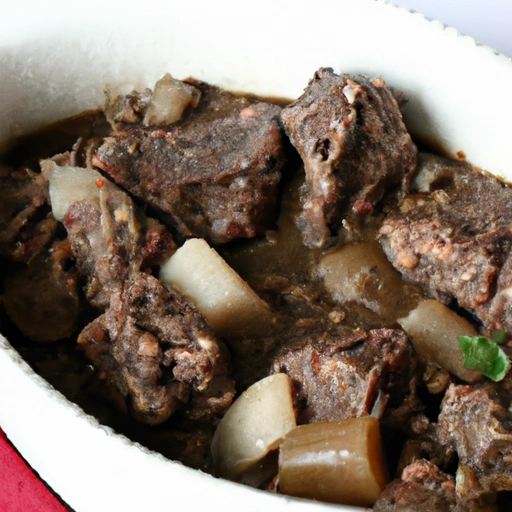Oxtail
Description

Oxtail refers to the tail of cattle, a traditional ingredient in many cuisines known for its rich flavor and gelatinous texture when cooked slowly. It's a bony, yet meaty cut that is often used in slow-cooked dishes such as soups, stews, and braises. Oxtail is sold in sections and can be found in most butcher shops or grocery stores, typically cut into short lengths for convenience. The weight of the oxtail can vary, but they often range from 7 to 8 pounds (3 to 3.6 kilograms) before trimming and cutting. In recipes, oxtail is usually measured in pounds or kilograms, but individual pieces can also be counted if preferred.
Common uses
Oxtail is commonly used as the star ingredient in rich, hearty dishes that benefit from a long, slow cooking process. It's particularly popular in the colder months when warming, comfort foods are in demand.
Nutritional value
Calories
Oxtail is relatively high in calories, with a single serving (100g) providing approximately 262 calories.
Protein
It is a good source of protein, offering about 30 grams per 100g serving.
Fat
Oxtail is also high in fat, with around 14 grams per 100g, which contributes to its rich flavor.
Carbohydrates
This ingredient contains a minimal amount of carbohydrates, less than 1 gram per 100g.
Vitamins
Oxtail provides a range of B-vitamins, particularly vitamin B12 which is essential for red blood cell formation and neurological function.
Minerals
It is a rich source of minerals such as iron, selenium, and zinc, all of which are crucial for various bodily functions including immune system health and wound healing.
Health benefits
The gelatin found in oxtail can be beneficial for joint health, while the protein content helps in muscle repair and growth. The rich mineral content supports a healthy immune system and aids in maintaining overall bodily functions.
Potential risks
Due to its high fat content, particularly saturated fat, excessive consumption of oxtail can lead to increased cholesterol levels and associated health risks. It should be consumed in moderation, especially by individuals with heart conditions or those monitoring their fat intake.
Common recipes
Oxtail is best known for its use in oxtail soup, a traditional dish in many cultures. It's also used in rich stews, braised dishes, and to create flavorful stocks and broths.
Cooking methods
Slow cooking methods such as braising, stewing, and simmering are most commonly used to cook oxtail, allowing the flavors to develop and the meat to become tender.
Pairing with other ingredients
Robust flavors and spices such as thyme, bay leaves, and allspice complement oxtail well. It pairs beautifully with root vegetables like carrots and potatoes, as well as grains like rice and barley.
Summary
Oxtail is a hearty and flavorful ingredient that shines in slow-cooked dishes. Its rich nutritional profile provides numerous health benefits, but it should be enjoyed in moderation due to its high fat content. With its historical roots in European cuisine, oxtail has become a beloved ingredient across various cultures and culinary traditions.